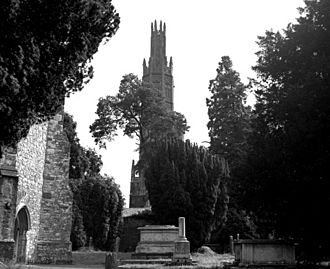Hadlow Castle facts for kids
Quick facts for kids Hadlow Castle |
|
|---|---|

Hadlow Castle, 1977
|
|
| Alternative names | May's Folly |
| General information | |
| Type | Folly |
| Architectural style | Gothic Revival |
| Town or city | Hadlow |
| Country | United Kingdom |
| Coordinates | 51°13′25″N 0°20′20″E / 51.22361°N 0.33889°E |
| Construction started | c1785 |
| Completed | 1852 |
| Renovated | 2011–13 |
| Demolished | 1951 (apart from tower and courtyard buildings) |
| Height | 170 feet (52 m) |
| Design and construction | |
| Architect | George Ledwell Taylor |
Hadlow Castle was once a large country house in Hadlow, Kent, England. It was built in the 18th century in a popular style called Strawberry Hill 'Gothic'. This style made new buildings look like old castles.
Over time, the house became much bigger. But in the 20th century, most of it was taken down. Only a tall tower and some smaller buildings were saved. This tower, known as Hadlow Tower, is a Grade I Listed structure. People in the area often call it May's Folly. It was fully repaired in 2013.
The Story of Hadlow Castle
Hadlow Castle was built where an older house, Hadlow Court Lodge, once stood. Construction began around the late 1780s. Walter May ordered the building, wanting it in a fancy Gothic style. J. Dugdale was the architect for this first part.
Walter May's son, Walter Barton May, took over the estate in 1823. He added a huge 170 feet (52 m) tall octagonal (eight-sided) tower in 1838. George Ledwell Taylor designed this impressive tower. In 1840, a 40 feet (12 m) tall octagonal top section, called a lantern, was added. Another smaller tower was built in 1852 but was later removed in 1905.
Walter Barton May passed away in 1858, and the castle was sold. Over the years, it had several owners. One owner, Dr. MacGeagh, bought it in 1891. He would travel by carriage to Tonbridge and then take a train to London. This made him an early commuter, someone who travels a long distance to work.
The castle stayed with the Pearson family until 1946. During the Second World War, it was used as a lookout tower. The Home Guard and Royal Observer Corps watched from it.
After the war, the castle was empty and changed hands many times. In 1951, most of it was torn down. However, the servants' quarters, stables, and the Coach House were saved. The painter Bernard Hailstone helped save the Coach House. The tall tower was already a protected building, so it was also saved. Today, the castle's entrance gate and lodges still stand. The Stable Court, with its two turreted buildings, is also still there. New homes have been built on the old castle grounds.
Hadlow Tower: A Tall Folly
Hadlow Tower, also known as May's Folly, is a very tall Victorian Gothic tower. A "folly" is a building made mostly for decoration, not for living in or for practical use. This tower is one of the biggest follies in Britain. The top 40 feet (12 m) of the tower is an octagonal lantern, which looks like a lighthouse top.
The tower is a Grade I listed structure, meaning it's very important and protected. However, it was badly damaged in the Great Storm of 1987. The lantern section had to be removed in 1996 because it was unsafe. After this, the tower's condition got much worse. Experts thought it would cost about £4 million to fix it.
In 2006, the local council, Tonbridge and Malling borough council, decided to take action. They announced they would use a compulsory purchase order (CPO) to buy the tower. This meant they could buy it even if the owner didn't want to sell, to make sure it was saved. The plan was for the council to own the tower and then give it to the Vivat Trust. The Vivat Trust is a charity that restores historic buildings. They planned to turn parts of the tower into holiday homes and have an exhibition area on the ground floor.
In 2011, the council officially bought the tower and sold it to the Vivat Trust for just £1. The restoration work began in February 2011. This included putting the lantern back on top. The project received money from English Heritage and the Heritage Lottery Fund. The Heritage Lottery Fund gave £2 million of the estimated £4 million needed for repairs.
The restoration was finished in February 2013. This made Hadlow Tower the tallest folly in the United Kingdom. In October 2013, the restoration won an award. The Vivat Trust and the Save Hadlow Tower Action Group (SHTAG) were recognized for their efforts. The inside of the tower was also completed. The exhibition center on the ground floor was open on Thursdays from May to October. SHTAG organizes visits for the public. In September 2014, the tower was nominated for the 2014 Kent Design Awards.
After the Vivat Trust closed down, the tower was put up for sale in May 2016. In 2017, a private person bought the tower for £425,000. It was listed for sale again in 2020 for £1,475,000.


